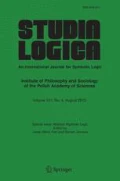Abstract
Features are unary operators used to build record-like expressions. The resulting term algebras are encountered in linguistic computation and knowledge representation. We present a general description of feature logic and of a slightly restricted version, called record logic. It is shown that every first-order theory can be faithfully interpreted in a record logic with various additional axioms. This fact is used elsewhere [15] to extend a result of Tarski and Givant [14] on expressing first order theories in relation algebra.
Similar content being viewed by others
References
H. Aït-Kaci and R. Nasr. Login: A logic programming language with built-in inheritance. J. Logic Programming, 3, 1986. 185-215.
H. Aït-Kaci, A. Podelski, and G. Smolka. A feature constraint system for logic programming with entailment. Theoretical Computer Science, 122, 1994. 263-283.
R. Backofen. A complete axiomatization of a theory with feature and arity constraints. J. Logic Programming, 24 (1,2), 1995. 37-71.
R. Backofen and G. Smolka. A complete and recursive feature theory. Theoretical Computer Science, 146, 1995. 243-268.
B. Carpenter. The logic of typed feature structures, volume 32 of Cambridge Tracts in Theoretical Computer Science. Cambridge University Press, Cambridge, 1992. viii+270pp.
J. D. Monk. Mathematical logic. Springer verlag, New York, 1976. x+531pp.
H.B. Enderton. A mathematical introduction to logic. Academic press, New York, 1972. xiii+295pp.
M. Minsky. A framework for representing knowledge. The psychology of computer vision (editor P.H. Winston). McGraw-Hill, New York, 1975. 211-277.
W.C. Rounds and R. Kasper. A complete logical calculus for record structures representing linguistic information. Proc. 1st Ann. Symp. on logic in Computer Science, 1986. 38-43.
J.R. Shoenfield. Mathematical logic. Addison-Wesley, Reading, 1967. vii+344pp.
G. Smolka. Feature-constraint logics for unification grammars. J. Logic Programming, 12, 1992. 51-87.
G. Smolka and R. Treinen. Records for logic programming. J. Logic Programming, 18(3), 1994. 229-258.
J.F. Sowa. Conceptual structures: information processing in mind and machine. Addison-Wesley, Reading, Mass., 1984. 481 pp.
A. Tarski and S. Givant. A formalization of set theory without variables, volume 41 of Amer. Math. Soc. Colloq. Publ. Providence, R.I., 1987. xxi+318pp.
M. van de Vel. Relation algebra with feature symbols. Vrije Universiteit Amsterdam, preprint, 2002. 60pp.
Author information
Authors and Affiliations
Rights and permissions
About this article
Cite this article
van de Vel, M. Interpreting First-order Theories into a Logic of Records. Studia Logica 72, 411–432 (2002). https://doi.org/10.1023/A:1021849625062
Issue Date:
DOI: https://doi.org/10.1023/A:1021849625062




